After a price war filled with gunpowder, the smart electric vehicle market opened up a new internal competition model - Internal Competition 2.0.
Entering the era of inner roll 2.0, host manufacturers are no longer just focusing on roll prices, but also innovating roll characteristics, roll frequency, and roll agility.
The direction of the host factory roll will have a huge impact on the development mode and supply chain mode.
The goal is to master highly differentiated and knowledgeable core technologies, either by bypassing Tier 1 self-development or by forming a technical team to directly communicate with core hardware and software suppliers. This will determine what role suppliers can play, Tier 1.5、Tier 2……
With high-frequency innovation, the automotive development cycle has been shortened, entering the "Moore's era", which severely tests the development ability, engineering and technical service ability, and pre research ability of suppliers.
The rapid technological evolution and transformation of intelligent electric vehicles require the entire automotive supply chain to complete iteration and incremental delivery through deep integration and joint innovation.
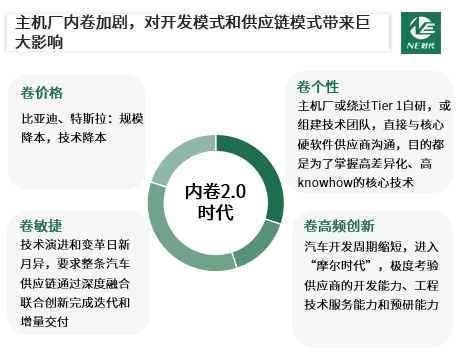
Image: NE Era
one
Under the trend of E/E integration, three technological routes have evolved
As the underlying carrier of electrification and intelligence, the various domains and degree of integration of the vehicle's electronic and electrical E/E architecture determine the upper limit of electrification and intelligence for a vehicle model.
The E/E architecture has evolved from distributed to domain centralized, and is divided into five major domains according to function: power domain, body domain, chassis domain, cockpit domain, and intelligent driving domain. The five domains are independent of each other and connected through Ethernet and CANFA.
On the basis of functional domains, in order to enhance software and hardware collaboration and reduce costs, multiple domains are fused and controlled by cross domain control units. The ultimate form of E/E architecture is the central computing electronic and electrical architecture, which is the development of a central computing platform with more computing power and stronger algorithms, supporting data transmission and computing processing within regional controllers. At this point, the decrease in the cost of vehicle components will be evident.
Mainstream host manufacturers are committed to the development of central integrated E/E architecture, but due to technical difficulties, there is currently a transitional stage of E/E architecture, which integrates functional and positional domains into cross domain or central integrated solutions: (1) quasi central computing platform (intelligent driving, intelligent cabin)+regional controller (body, chassis, thermal management)+powertrain (not fully integrated into multiple domains); (2) Vehicle control domain+intelligent driving domain+intelligent cabin domain+powertrain, (3) power domain (multi in one deep integration)+body domain/vehicle control domain+cockpit domain/intelligent driving domain.
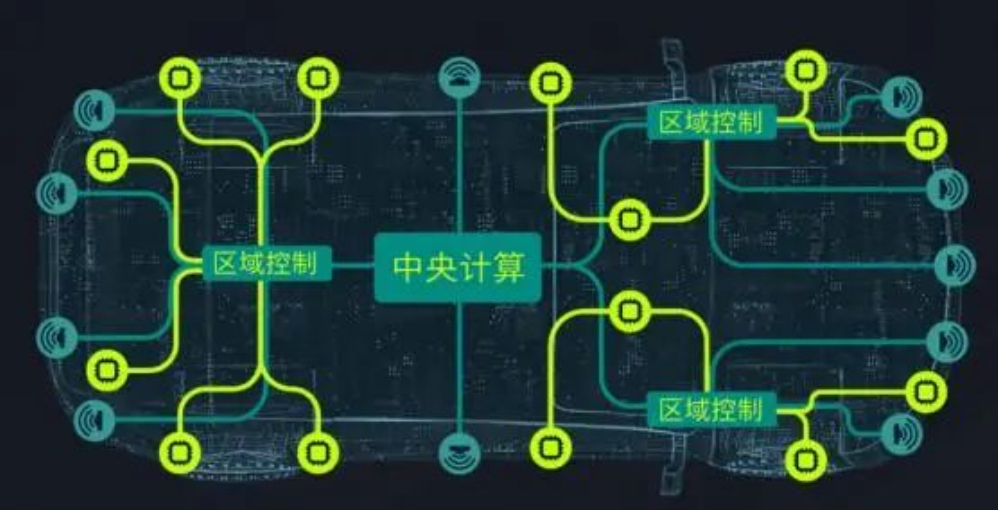
Xiaopeng X-EEA3.5
The second type of E/E architecture represents host manufacturers - NIO, Ideal, Geely, Great Wall, SAIC, and GAC. The intelligent driving domain and intelligent cabin domain are separated, and the vehicle control domain integrates ECU such as vehicle control, body, gateway, etc., mainly responsible for the management of motion and energy. Similar to the first type of E/E architecture, the power system is not deeply integrated. The next generation E/E architecture plan for this type of host factory is based on a quasi central computing platform+regional controller, with a focus on intelligent cross domain integration.
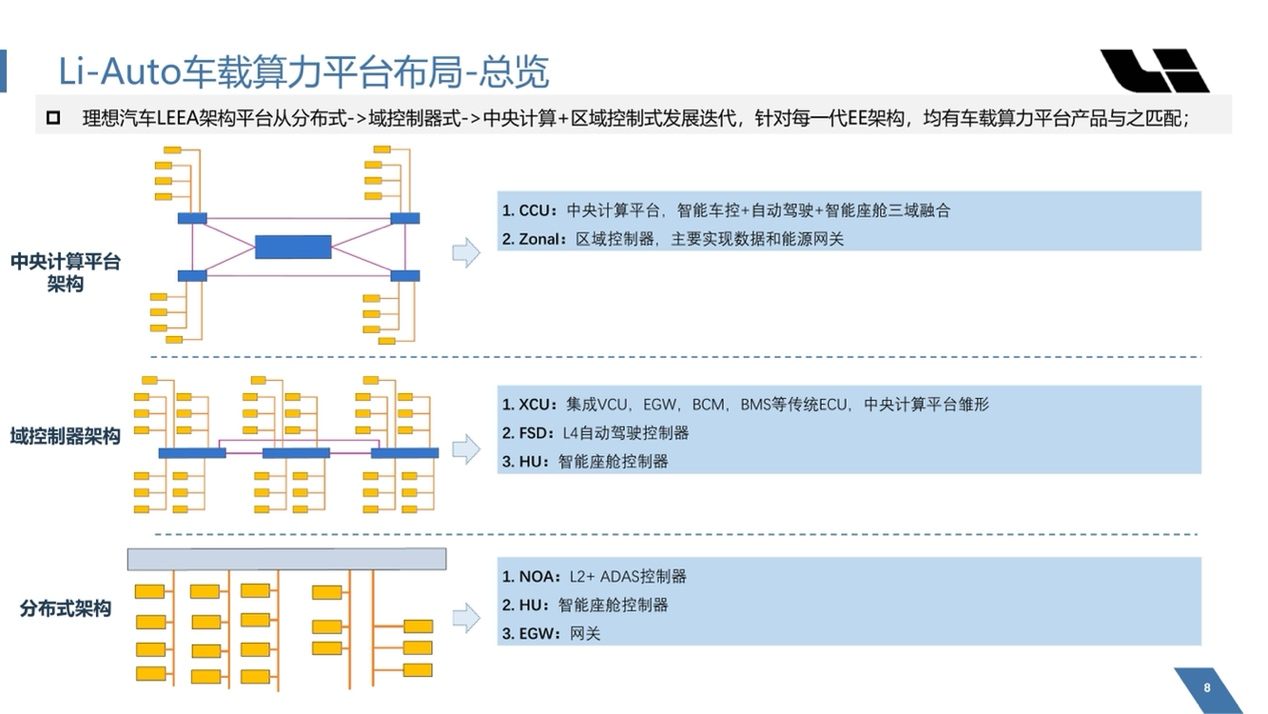
The iteration of the Ideal Automotive EEA architecture, currently the domain controller architecture
The third type of E/E architecture represents host manufacturers - BYD, Changan Shenlan, and Dongfeng Nano. The power domain that integrates five to eight modules, including MCU (Motor Control Unit), VCU (Vehicle Controller), BMS (Battery Management System), OBC (Vehicle Charger), DCDC (DC Converter), PDU (High Voltage Distribution Unit), TMCU (Thermal Management), PTC High Voltage Drive, is the most important domain control for this type of host factory. In addition, BYD has deployed regional controllers, responsible for the integration of body related ECUs according to regions, and intelligent domain controllers, responsible for the control of intelligent cabins and intelligent driving. The intelligent domain is also a key focus of BYD's recently released Xuanji architecture, indicating that it has elevated the development of the intelligent domain to a higher level after the power domain. Changan self-developed vehicle domain controller, mainly integrating seven control modules including VCU gateway, Ethernet gateway, Tbox, etc.
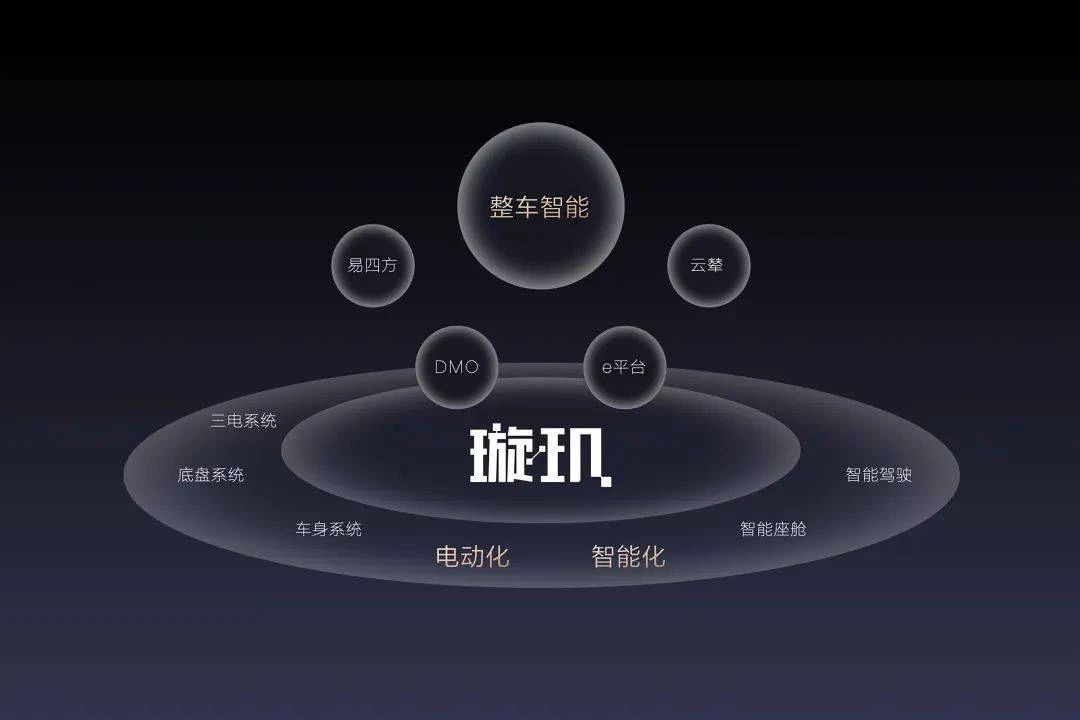
Image source: BYD
Based on various E/E architecture solutions and development focuses, there are almost no host factories that can simultaneously excel in both the power domain and the central computing platform/intelligent driving cabin domain.
The plan has not been fully finalized, and there are many supporters behind domain control, cross domain fusion, and central computing platforms. With years of exploration, host manufacturers have gradually figured out the high and low barriers to hardware and software that support the development of various technological routes, in order to find more suitable development and cooperation models for themselves.
two
Intelligent driving intelligent cabin domain: longer chain
In order to highlight the encirclement of "intelligent experience" and occupy the high ground of user mentality, host manufacturers are generally committed to developing a central computing platform that integrates intelligent driving domain and intelligent cabin domain, and promoting the implementation of software defined cars.
The control of autonomous driving and cockpit domains is more complex, requiring higher computational power and algorithms, and involving higher hardware and software barriers. From the current situation of EE architecture in host factories, most domestic intelligent driving and intelligent cabin systems are separated and established. Among them, intelligent driving domain control is currently the focus of attention and self-developed by OEMs. Therefore, this article focuses on the development and cooperation models of intelligent driving domain control, which are divided into three categories:
1. Intelligent driving self-developed full stack, Tier OEM chip/domain controller
2. Intelligent driving independently designs controllers, develops some algorithms, and Tier provides hardware, underlying software, or middleware, etc
3. Intelligent driving with full stack self-control, Tier provides hardware and software integrated products
The first type of representative - Tesla, with the goal of 100% self-developed controllers, all independently designed hardware and software, covering the computing chips, controller hardware, system software, and algorithms of intelligent driving domain control. This is a fully stack self-developed development model.
The second type of representatives - Zero Run, NIO, BYD, Xiaopeng, Ideal, SAIC, Geely, and Great Wall. Among them, Xiaopeng, Ideal, BYD and others formed an internal team to independently develop some algorithms, design motherboards, and external suppliers completed the production of domain control hardware and underlying software. NIO, Geely, and others are developing their own chips. SAIC, Geely, and Great Wall have incubated a group of technology companies based on their internal R&D teams, such as SAIC's Zero Beam Technology, Geely's Yikatong, and Great Wall's Millimeter Intelligence, which have acquired the ability to develop controller hardware and software. In addition to these technology companies, host manufacturers also adopt software and hardware integrated solutions from third-party suppliers. This is a development model that focuses on self-developed algorithms and outsourcing hardware and software.
The third type of representatives - Chang'an and Dongfeng. Both companies emphasize more on "full stack controllability" and build independent and controllable full stack intelligent core capabilities. This is a full stack self-control development model that provides a win-win experience for end consumers through symbiosis with partners in the ecosystem.
From this, we can see that the core goal of automotive companies is to accumulate full stack knowledge, grasp core technologies, build competitive barriers, and ensure the integrity and security of the supply chain. There are still many suppliers participating in the self-development process.
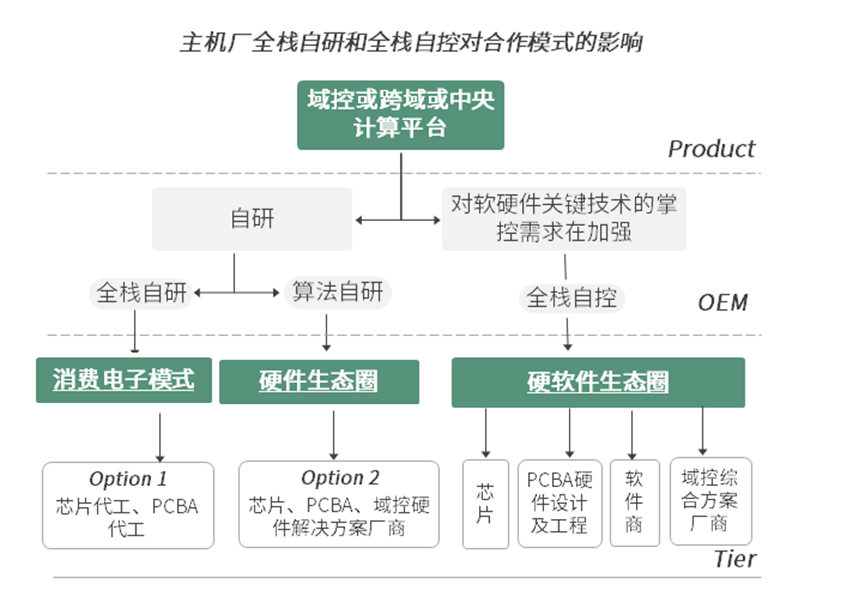
Image source: NE Era
Compared to the power domain, the supply chain of central computing platforms is longer, and the role of "coupling agents" has become more important.
As a "coupling agent", enterprises can be either chip companies, software companies, or domain control companies. Chip companies such as Nvidia and Horizon rely on chips and toolchains to establish strong ecological moats. Desai Xiwei and Jinmai Electronics have become partners of host manufacturers and Tier 1 domain control suppliers with their rich chip resources, hardware design, toolchain, underlying software, middleware, and fully integrated hardware and software capabilities. Millimot, Yikatong, and other products are most suitable for host manufacturers, helping them strengthen their management of critical hardware and software supply chains.
three
Power domain: The host factory has stronger control ability, and suppliers at all levels face challenges
According to the research of NE Era, the development and cooperation models of the power domain can also be divided into the following three types:
(1) The host factory independently develops and manufactures the assembly and electronic control subsystem, and the supplier provides a small amount of PCBA
(2) Self developed and self-made assembly by the host factory, with all or part of the purchased electronic control subsystems and power modules, as well as PCBA hardware and software
(3) The host factory leads the design or application, and the assembly is manufactured by the supplier
The first development model requires higher integrity and capacity scale of the vertical integration supply chain of the host factory. At present, BYD, Dongfeng and others have achieved complete self-developed and self-made assembly and electronic control; NIO has developed its own MCU, while adopting a combination of outsourced systems and self-developed hardware and software for BMS.
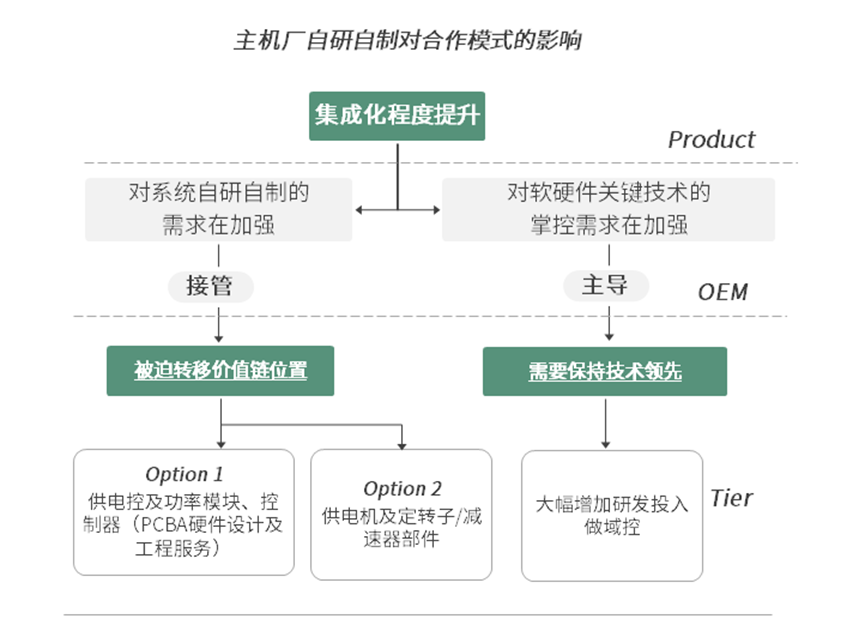
Image source: NE Era
Electric drive systems, BMS, thermal management, etc. are all products with strong customization. How to integrate, how deep the integration is, whether to prioritize performance or cost, all need to be carried out in conjunction with the positioning of the vehicle model by the host factory. Only by personally participating in innovation can host manufacturers ensure product leadership.
On the other hand, the power domain has relatively low requirements for computing power and algorithms, mainly involving control instruction calculation and communication resources. The technology is more mature and relatively simple. This enables the host factory to establish a software team and explore the integration of multiple controllers.

Image source: Zhineng Zhixin
The focus of the first two development models is on the host factory taking over the role of Tier 1, leading to third parties being forced or actively shifting their value chain positions. The original third-party Tier 1 began providing subsystems such as motors and electronic controls, while Tier 2 transitioned from an electronic control supplier to a power module supplier and a controller PCBA hardware and software supplier.
According to data compiled by NE Era, BYD, Shenlan Automobile, BAIC New Energy, SAIC, and others have taken over the development and application of the multi in one (with more than three integrated components) supporting system. Both BAIC and Shenlan have adopted third-party suppliers' multi in one controllers, such as CRRC's electric drive serving Shenlan and Magmet's contract manufacturing for BAIC.
The multi in one market left for third parties can be divided into two situations: 1. LG's eight in one electric drive system is SAIC GM's self-developed Autotronic multi in one system; 2. Cost oriented small and medium-sized electric vehicles tend to rely more on third-party packaging solutions from the perspective of reducing BOM and management costs. At this moment, only suppliers who increase investment in domain control can take on the olive branch thrown by the host factory and provide domain control development and engineering services for the host factory.
This is both an opportunity and a challenge for electronic control suppliers.
From three in one to multiple in one, the more integrated functions there are, the higher the complexity will be. At present, domain control is moving from the design of multiple main control chips/multiple PCBA control boards to the development of multiple main control chips/single PCBA boards. With the increase in computing power and interface resources of the main control chip, it has developed into a domain control multi integration of a single main control chip/single PCBA board.
Faced with the functional requirements proposed by host factories from the architecture level, especially those who start domain control development from scratch, electronic control suppliers have service experience downwards, integrate chip and other component supplies and software platforms upwards, deepen the technology and resource links between upstream and downstream, help host factories build a simple and easy-to-use platform development environment, software layering, hardware modular design and engineering services, and facilitate customer customization of functional layers and vehicle strategy development.
four
Joint innovation to alleviate high-frequency innovation anxiety in host manufacturers
As the E/E architecture continues to evolve towards cross domain integration and central integration, both host factories and supply chains are exploring the most suitable cooperation models for electrification and intelligence, opening up in games and innovating in openness.
Game theory is about wanting to occupy the technology or product with the highest value of a bicycle, and clarifying one's position in the entire supply chain.
Openness means that each has its own technological advantages and needs to complement each other to create a vehicle with a differentiated experience.
Leading domestic and foreign semiconductor companies such as NVIDIA, Horizon, and Infineon, as well as controller hardware and software design and engineering companies such as Desai Xiwei, choose from each other and embrace cooperation. They discuss chips and the latest technologies that have not yet been standardized, complete the judgment of new technologies, new demands, and new trends ahead of market time, and assist host manufacturers in adaptive research and development. Whoever completes the research and development first and gains recognition from the host factory can shoot the first shot in the market.
Ultimately, the game and cooperation in the supply chain will greatly help host factories alleviate high-frequency innovation anxiety.
Almost every host factory has a serious high-frequency innovation anxiety, and after communicating with multiple host factories, the NE era has discovered this.
In the Moore era, the iteration speed accelerated, and the R&D cycle of OEMs was reduced from about 4 years in the era of fuel vehicles to 3 years in the era of new energy vehicles, and then pushed to the limit of 12-18 months by new forces in the automotive industry. The fast-paced technological updates allow users to experience the update speed of "fast-moving consumer goods" mobile phones on "large durable consumer goods" cars.
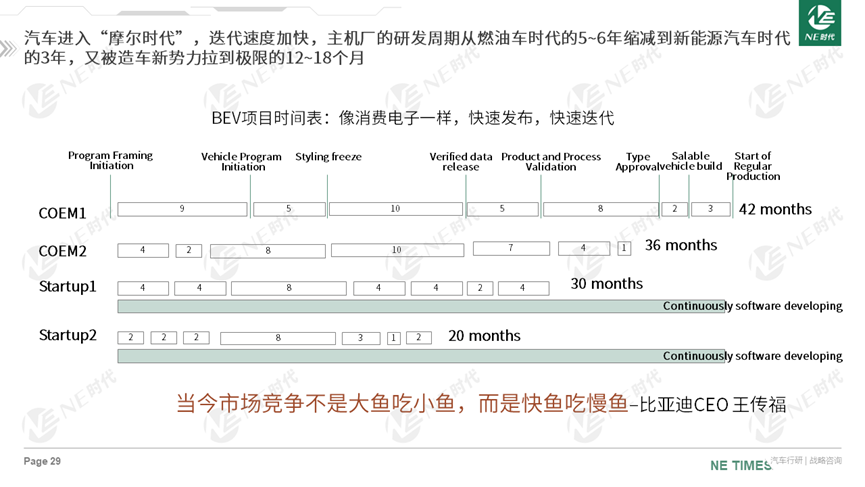
In the fields of intelligent driving and intelligent cabin, almost all intelligent electric vehicles are working for Qualcomm and Nvidia. The Qualcomm 8155 chip, 8295 chip, NVIDIA orin chip, Thor chip have successively become the top synonyms for smart cabin and smart driving in host manufacturers.
After the implementation of high-speed NOA on a large scale, urban NOA has officially entered the stage of competing for the best. From the perspective of the landing process, Xiaopeng, Avita, NIO, and Ideal have already landed in 2023, followed by Zhiji, BYD, and Jike in 2024. From the perspective of open cities, Huawei plans to have city NOA coverage nationwide by the end of the year, while Xiaopeng announced the expansion of city NOA to 50 cities by the end of the year. Ideal AD Max also plans to "capture" 110 cities by the end of the year. NIO is also not to be outdone and is confident in completing a 250000 kilometer route verification by the end of the year, with NOAs covering 200 cities.
Xiaopeng Automobile, a leading manufacturer of electronic and electrical architecture in domestic automotive companies, completed three iterations of the E/E architecture from 2018 to 2022, moving from distributed XEEA 1.0 to domain control of XEEA 2.0 and upgrading to hardware architecture of central supercomputing and regional control of XEEA 3.0. It is currently developing its own 4.0 and will implement one box one board, integrating all systems on one board. It is expected to reduce costs by 40% and improve performance by 50%.
The fierce competition of chip selection, NOA implementation, and E/E architecture iteration is everywhere, which greatly tests the innovation capabilities of host manufacturers and supply chains. It is undeniable that "innovation anxiety" has brought new impetus to the transformation of intelligent electric vehicles.
The technological evolution and transformation of intelligent electric vehicles are in full swing, with new technologies, products, formats, and models constantly emerging. How far electric intelligence can go may depend on whether the upstream and downstream can leverage more internal and external resources across the chain.
The content information is sourced from the internet and is for reference only. If there is any infringement, please contact us to delete the post.


